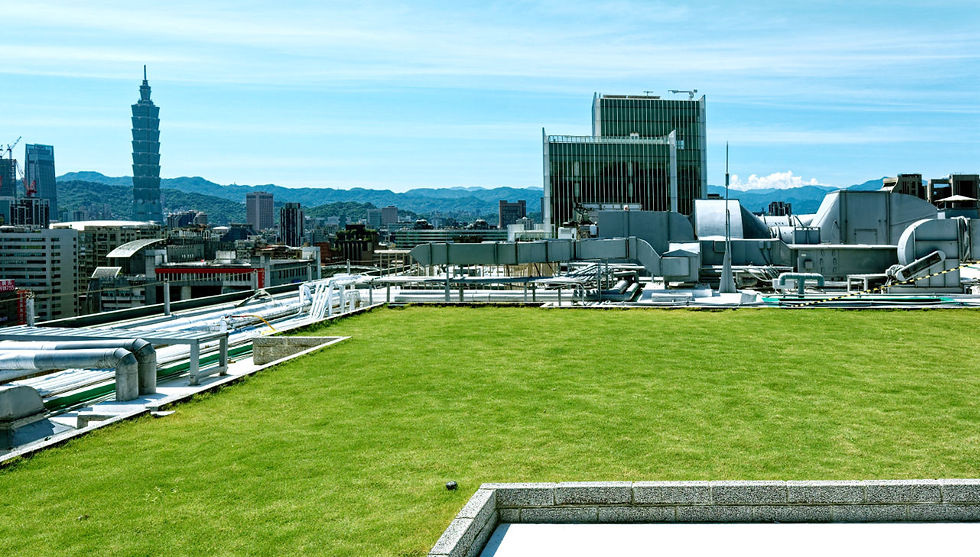An Urban Oasis
- Tim Shen
- Jan 16, 2024
- 3 min read

In an earlier article, we discussed the growing problem of Taipei’s rising temperatures, driven by climate change and exacerbated by dense development of buildings and roads. This is a phenomenon known as the Urban Heat Island Effect where concrete, tarmac and similar materials absorb heat from the sun during the day and radiate it back into the surroundings well into the night, causing ambient temperatures in built-up places to be significantly higher than those in nearby areas that are less densely developed or more rural.
As global temperatures rise, the impacts of the Urban Heat Island Effect become increasingly acute, posing both environmental and public health risks. Because buildings contribute to this issue, it’s important that a green building do everything it can to minimize its impact on local temperatures, and LEED encourages just this in a credit dedicated to the problem.
As part of our LEED green building transformation process, Hung Kuo Building invested in comprehensive improvements to reduce our contribution to the Urban Heat Island Effect.
The total surface area of mitigating measures installed at Hung Kuo Building as part of our LEED certification spans 2,318 square meters. This represents 46% of the total site area and is a 77% increase from the situation before LEED.
The mitigation effort that is most obvious to building occupants and passers-by alike is the landscaping installed around the exterior of the building on the ground level. We’ve always had landscaping around the building, but while we were working towards LEED certification, we needed to replace the old landscaping to conduct periodic maintenance and waterproofing work to protect the basement levels.

We took advantage of this situation to redesign our landscaped area. We’ve added new trees that will expand their canopy to provide shade cover over more paved area during the next decade. We’ve planted over a 100 square meter area that was previously paved, and installed a 84 square meter trellis above the entrance to the car park which is being grown over with Firevine Pyrostegia venusta that bursts into stunning orange blooms in the spring and early summer.
The most significant improvement can only be properly seen by flying over the building, or from outer space!(1) Before the installation of our new sustainable roof, we applied a coat of thick, dark-green, weatherproof paint to provide waterproofing against the most torrential rains. This roof coating needed minimal maintenance during the many years it would last before needing to be re-applied. However, because it was dark green, it absorbed a lot of solar radiation during the hot summer months and acted as a heating element for the top floor of the building, requiring a lot of energy to keep that space cool.
We decided to replace this with the most sustainable solution we could manage. Ideally, we’d have a completely vegetated roof, but because of the significant amount of building systems equipment, ducts and pipes installed atop the building, and the safe access needed for technicians to service them, that wasn’t an option. Instead, we placed vegetated areas where people didn’t need to walk and the rest of the roof, including under the ducts and equipment, is painted in a highly reflective, waterproof white paint.
This new white and green roof has solved the problem of absorbing the sun’s energy and heating the top floor in the summer, by either reflecting the solar radiation back into the sky or absorbing it in the leaves of the grass, with the soil providing additional insulation. While the grassy areas of roof are basically self-sustaining with the help of our automated irrigation system controlled by rainfall and soil moisture levels, the white roof needs a lot of maintenance and is the complete opposite to the old green roof in this regard.

We send a maintenance team up to the roof at least once a month to inspect the condition of the white paint and conduct spot-cleaning where necessary to ensure its effectiveness in reflecting the sun’s rays. Twice a year we give the entire white roof a thorough clean and patch up areas that may have experienced wear from typhoons and similar inclement weather.
In one sense, it’s a lot of additional work, but we believe it’s worth it. The occupants on the 19th floor have told us they’re a lot more comfortable during Taiwan’s long hot summers, and we know the new roof is also contributing to reducing the heat island effect in our neighborhood, which helps everyone.



Comentários